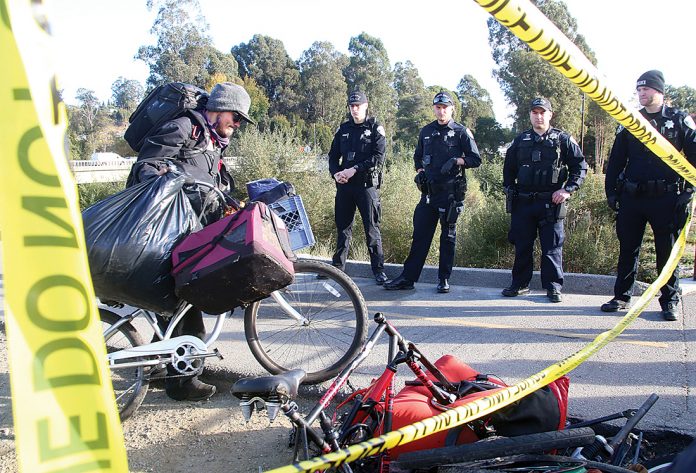
SANTA CRUZ COUNTY—The Santa Cruz County Grand Jury every year investigates different aspects of local government and civic operations throughout the county, and its findings typically produce detailed reports of positives and negatives found during the investigations.
But while those investigated are required to respond to the reports—and to publicly report the actions they take to implement the jury’s recommendations—they are not required by law to follow through on those actions.
For that reason, the Grand Jury this year took a look at a handful of investigations from 2016-17 to see whether any of the recommendations were implemented.
The report, titled “Honoring Commitments to the Public,” was one of 10 that the Grand Jury released in June and July.
Specifically, the county revisited reports on school safety, how Pajaro Valley Unified School District is utilizing Measure L funding, the county’s syringe services program and the county’s public bus system.
“The commitments made in 2017 have now had sufficient time to bear fruit,” the report states. “Thus, we report them now.”
The jury found that, in general, the organizations “fulfilled the commitments they made to the public.”
The remainder of this year’s reports are a sizable agglomeration of 10 investigations ranging from behavior at Santa Cruz City Hall to fire services to voter information security.
The all-volunteer group convenes every year to take a deep dive into local governmental affairs, a process codified in California law.
“It’s about citizens really keeping their government accountable,” says Bruce Gritton, who served as foreperson for this year’s 19-member Grand Jury.
After a grand jury report is released, the agencies in question typically have up to 90 days to respond. These responses usually contain several agreements and disagreements with the allegations.
Britton says that the jurors go into the year-long project knowing the reports do not carry any real legal weight.
“The real pressure for change needs to come from the citizenry that sees the reports,” he says. “They need to make sure their government is held accountable.”
Here is a look at other Grand Jury investigations:
Homelessness
The homelessness problem in Santa Cruz County, and the lack of a solution after years of efforts, is due in large part to an unwillingness by community members to allow shelters and other projects into their neighborhoods. This so-called NIMBYism (Not In My Backyard) is fueled by a lack of political will by city and county leadership, according to the Grand Jury.
Those assertions are among a host of findings in one of the final Grand Jury reports for the 2019-20 year.
The report, titled “Homelessness: Big Problem, Little Progress,” also criticizes the bi-annual Point-in-Time report, which the Grand Jury says is inaccurate and results in inadequate allocation of state and federal resources.
Another problem, the report says, is a lack of coordination between homeless services providers.
In addition, the Homeless Action Partnership lacks the “authority, structure, leadership, staff, training or processes,” and is therefore “ineffective in its mission of reducing homelessness,” the report states.
The Grand Jury says the county has a dearth of treatment facilities, and says that a lack of prevention and diversion programs means that many people who could stay in their homes with some cash assistance instead become homeless.
The county has land that could be used for housing, the report says, and urged civic leaders to identify possible sites that could be used for homeless services, as well as temporary or permanent shelters.
The report was also critical of Santa Cruz County law enforcement response to homeless, addiction and mental health issues, which it says often criminalizes behavior that would be better addressed with mental health training.
Instead, the county should create a 24-hour mobile crisis response unit, which would include medical personnel and a crisis worker for calls that do not involve legal issues or threats of violence.
The Grand Jury said that county and city leaders should by the end of the year create a Community Task Force that would collaborate in solving homeless issues.
In addition, the county should train the inmates at the Rountree medium-security jail facility to build small housing structures such as tiny homes.
In a hefty 60-page tome detailing the county’s preparedness for risk from calamities such as financial catastrophe, natural disaster and global pandemic, the Grand Jury found that local government agencies are underprepared, and that cities should align their risk assessment framework with that of the California Auditor’s Office.
“Our findings indicate that all of our cities are just one economic shock away from serious financial distress, and that their current approach to risk management is not adequate to effectively manage and mitigate the range of risks that are typically confronted by local governments,” the report states.
The Grand Jury urges the county’s jurisdictions to get a grasp on the risk associated with rising pension costs, and prognosticates that, with Covid-19 having brought the world to a financial halt, calamity is likely on its way.
The Grand Jury made no allegations that the Santa Cruz County Elections Department has mishandled voter registration data. In fact, the report offers its praise, stating that its procedures “comply with all local, county, state, and federal laws and regulations governing Collected Data and Distributed Data.”
But it said the department should change the way it distributes publicly available voter registration data.
Rules governing such distribution, the report states, were established in 1994, long before identity theft and phishing attacks were a thing.
Those requesting such data could be doing so for fairly innocuous reasons, such as politicians contacting constituents or sending political mailings.
Under current procedures, however, voter data lists include personally identifiable information such as full birthdays, which can also be used for nefarious purposes such as identity theft, illegal sale of voter registration data, attempted election disruption, fraud, and cyber-extortion.
That should change to include only a birth year, the report states. The Elections Department should also ask those requesting voter data to include a narrative on why they are doing so.
After looking at six of the county’s 13 fire agencies responsible for performing safety inspections, the Grand Jury found that Santa Cruz and Watsonville Fire departments, along with Santa Cruz County Fire, have not “adequately inspected all schools, hotels, apartments, and licensed residential care facilities for fire and safety,” as required by state law.
Felton Fire District, meanwhile, has not accounted for its inspection of those facilities, the report states.
The agencies should tell their governing agencies what resources they would need to perform the necessary inspections, the Grand Jury recommends, and should all publish annual reports of their inspections.
The Aptos and Central Fire Districts, meanwhile, received praise for the “persistence shown” in performing their inspections and reporting the results.
The county’s website is replete with “missing, out-of-date and inaccurate” information, along with several broken links, the report says. The lack of updates makes it harder for citizens to inform themselves and to navigate county services.
This includes missing information from public meetings, among other things. Furthermore, the county lacks a process by which the website is reviewed and improved, and does not have a way for users to be alerted to website updates. Finally, the investigation found that, while web content providers often know the reasons behind the missing or out-of-date information, such information is typically not provided to the public.
To ameliorate the problem, the Grand Jury recommends formal processes for evaluating content, including a quarterly review.
The grand jury excoriated the Santa Cruz County Sheriff’s Office for being unprepared during a 26-hour power failure on Sept. 28, 2019, that affected the Main Jail and the Blaine Street Women’s Jail.
“Services were lost and backup failed to properly operate in several critical areas,” the report reads. “Clearly, the safety of inmates and jail personnel was compromised. This cannot be tolerated.”
The power outage killed all overhead lights in the jail housing units, along with perimeter security cameras and the ventilation system. In addition, fire evacuation doors were inoperable, the kitchen lost power and jail officials had to complete arrest records on paper. The investigation revealed, among other things, that the backup generator lacked the power for “mission critical” operations, and in any case there was not sufficient fuel to run the generator.
The report blames jail personnel for a lack of communication before, during and after an emergency, and for the fact that the jail had no policy for its response to such an emergency.
All of this violated county policy that among other things requires a working generator capable of a “seamless transition in the event of a loss of power,” those responsible for the generators were unaware.
The jail has since gotten a new generator, but has not yet tested it, the report says.











